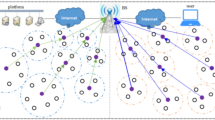Abstract
Cluster based routing in Mobile AdHoc Networks are considered one of the convenient method of routing. Existence of Cluster Head (CH) in a group of nodes for data forwarding improves the performance of routing in terms of routing overhead and power consumption. However, due to the movement of CH and frequent change in cluster members, cluster reformation is required and increases cluster formation overhead. The stability of the cluster highly dependent of stability of the CH and hence during CH selection special care should be taken so that the cluster head survives for longer time. In this paper a method of cluster formation is proposed which will take into account two most vital factor node degree and bandwidth requirement for construction of the cluster and selection of the cluster head. Further, when two clusters come closer to each other they merge and form a single cluster. In such case out of two CHs one has to withdraw the role and other will take over. A new mechanism of merging two clusters is also proposed in the paper. We call this method as an Improved Cluster Maintenance Scheme and primarily focused on minimizing CH changing process in order to enhance the performance. The stated method makes cluster more stable, and minimizes packet loss. The proposed algorithm is simulated in ns-2 and compared with Least Cluster head Change (LCC) and CBRP. Our algorithm shows better behavior in terms of number of clusterhead changes or number of cluster member changes.










Similar content being viewed by others
References
Royer, E. M., & Toh, C. K. (1999) A review of current routing protocols for ad hoc mobile wireless networks. IEEE Personal Communications Magazine, 1999, pp. 46–55.
Gerla, M., & Tsai, J. T. (1995). Multiuser, mobile, multimedia radio network. Wireless Networks, 1, 255–265.
Yadav, N. S., Deosarkar, B. P., & Yadav, R. P. (2009). A low control overhead cluster maintenance scheme for mobile ad hoc networks. International Journal of Recent Trends in Engineering, 1(1), 1–9.
Chiang, C. -C. et al. (1997). Routing in clustered multihop, mobile wireless networks with fading channel. In Proceedings of IEEE SICON’97, 1997, pp. 197–211.
Ephremides, A., Wieselthier, J. E., & Baker, D. J. (1987). A design concept for reliable mobile radio networks with frequency hopping signaling. In Proceedings of IEEE, Vol. 75, 1987, pp. 56–73.
Abolhasan, M., Wysocki, T., & Dutkiewicz, A. (2004). A review of routing protocols for mobile ad hoc networks. Journal of Ad Hoc Networks, 2, 1–22.
Gupta, P., & Kumar, P. R. (2000). The capacity of wireless networks. IEEE Transactions Information Theory, 46(2), 388–404.
Hong, X. Y., Xu, K. X., & Gerla, M. (2002) Scalable routing protocols for mobile Ad Hoc networks. IEEE Network, 16(4), 11–21.
Hong, X. Y., Xu, K. X., & Gerla, M. (2002) An Ad Hoc network with mobile backbones. In Proceeding on IEEE ICC 2002, Vol. 5, April–May 2002, pp. 38–43.
Yu, J. Y., & Chong, P. H. J. (2005). A survey of clustering schemes for mobile ad ho networks. IEEE Communication Surveys & Tutorials, 7(1), 32–48.
Abusalah, L., Khokhar, A., & Guizani, M. (2008). A survey of secure mobile ad hoc routing protocols. IEEE Communications Surveys & Tutorials, 10(4), 78–93.
Fall, K., & Vardhan, K. The network simulator (ns-2). http://www.isi.edu/nsnam/ns.
Agarwal, R., & Motwani, M. (2009). Survey of clustering algorithms for MANET. International Journal on Computer Science and Engineering, 1(2), 98–104.
Kioumourtzis, G. (2005). Simulation and evaluation of routing protocols for mobile ad hoc networks. Thesis, Master of Science in Systems Engineering and Master of Science in Computer Science, Naval Postgraduate School, Monterey, California, 2005.
Raju, R., & Mungara, J. (2010). Performance evaluation of ZRP over AODV and DSR in mobile adhoc networks using qualnet. European Journal of Scientific Research, 45(4), 658–666.
Pathak, S., Dutta, N., & Jain, S. (2014). An improved cluster maintenance scheme for mobile AdHoc networks. In IEEE 2014 international conference on advances in computing, communications and informatics, pp. 2117–2121.
Zeng, Y., et al. (2013). Directional routing and scheduling for green vehicular delay tolerant networks. Wireless Networks, 19(2), 161–173.
Meng, T., et al. (2015). Spatial reusability-aware routing in multi-hop. IEEE TMC Wireless Networks. doi:10.1109/TC.2015.2417543.
Dvir, A., et al. (2011). Back pressure-based routing protocol for DTNs.ACM. SIGCOMM. Computer Communication Review, 41(4), 405–406.
Zhang, Xin Ming, et al. (2015). Interference-based topology control algorithm for delay-constrained mobile Ad hoc networks. IEEE Transactions on Mobile Computing, 14(4), 742–754.
Yao, Y. et al. (2013). EDAL. An energy-efficient, delay-aware, and lifetime-balancing data collection protocol for wireless sensor. Networks, Mobile Ad-Hoc and Sensor Systems (MASS). IEEE 10th International Conference 2013, Oct 14-16, pp.182–190.
Song, Y., et al. (2014). A biology-based algorithm to minimal exposure problem of wireless sensor networks. IEEE Transactions on Network and Service Management, 11(3), 417–430.
Liu, L., et al. (2015). Physarum optimization: A biology-inspired algorithm for the steiner tree problem in networks. IEEE Transactions on Computers, 64(3), 819–832.
Li, P., et al. (2014). Reliable multicast with pipelined network coding using opportunistic feeding and routing. IEEE Transactions on Parallel and Distributed Systems, 25(12), 3264–3273.
Yen, Y.-S., et al. (2011). Flooding-limited and multi-constrained QoS multicast routing based on the genetic algorithm for MANETs. Mathematical and Computer Modelling, 53(11–12), 2238–2250.
Spyropoulos, T., et al. (2010). Routing for disruption tolerant networks: Taxonomy and design. Wireless Networks, 16(8), 2349–2370.
Vasilakos, A., et al. (2012). Delay tolerant networks: Protocols and applications. Boca Raton, FL: CRC Press.
Chiang, C. -C., Wu, H. -K., Liu, W., & Gerla, M. (1997). Routing in clustered multihop, mobile wireless networks with fading channel. In Proceedings on IEEE SICON’97, 1997, pp. 1–5.
Jiang, M., Li, J., & Tay, Y. C. (1999). Cluster based routing protocol. August 1999 IETF Draft. http://www.ietf.org/internetdrafts/draft-ietf-manetcbrpspec-01.txt.
Author information
Authors and Affiliations
Corresponding author
Rights and permissions
About this article
Cite this article
Pathak, S., Jain, S. A novel weight based clustering algorithm for routing in MANET. Wireless Netw 22, 2695–2704 (2016). https://doi.org/10.1007/s11276-015-1124-8
Published:
Issue Date:
DOI: https://doi.org/10.1007/s11276-015-1124-8




